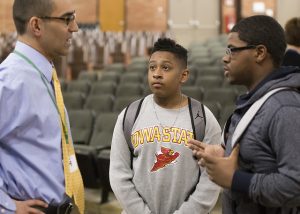ISU Professor Gives Boost to Hoover’s STEM Academy
When Dr. Raj Raman agreed to drive down from Ames this morning where he wears a lot of hats at Iowa State University (Associate Professor, Associate Director of Educational Programs; Office of Biorenewables Programs, Director of Graduate Education; Biorenewable Resources & Technology Interdisciplinary Graduate Program) to speak at Hoover High School, he figured to be preaching to the choir. After all, his audience was 9th and 10th graders in the school’s emerging STEM program. But who knew if he’d be able to get them singing?
Well, mission accomplished. In a freewheeling session that was long on Q&A and short on lecture, Dr. Raman’s introductory remarks quickly gave way to a lively give and take with the students about the many “flavors” of engineering and the importance of choosing the one that best suits an individual’s personal taste.
“I started out as an electrical engineer,” Dr. Raman recalled, slipping out of his sport coat and into his comfort zone. “Why? Because my dad told me to. Eventually I found my way into agricultural engineering because of my interest in the world food supply.”
On the stage behind him in the auditorium was the set for a drama production that looked like someone’s living room and Dr. Raman might as well have made himself at home on the sofa. This was no PowerPoint presentation.
Engineers need to be precise, whatever their field of specialty. But Dr. Raman emphasized a general point. “Don’t feel pressured to declare yourself in high school,” he said. “Now is the time to explore options. There will be plenty of opportunity to switch course along the way as you discover yourselves.”
Taking their cue, the students began peppering Dr. Raman with questions about the similarities and differences between a wide range of engineering disciplines, from aerospace (it truly IS rocket science) to industrial to civil to biomedical. More than ever before, they can be indistinct from one another. Areas of overlap are on the rise. Take the burgeoning field of prosthetics, for instance. Artificial limbs are getting so advanced that assorted experts might be called upon as new models are developed. Mechanical engineers, as well as electrical and biomedical ones, might all be able to lend a hand, so to speak.
“We’re talking about the transferability of skills,” Dr. Raman said. “Engineers all have one fundamental trait in common. We’re creative problem-solvers.”
Dr. Raman’s visit today was at the invitation of Maureen Griffin who is the Coordinator of Hoover’s STEM Academy. She’s worked with him before.
“Eric Hall (Hoover chemistry teacher) and I and some others have been up at ISU’s Center for Biorenewable Chemicals (CBiRC) during the summers doing research and professional development towards getting the academy established,” she said. “Raj is a tremendous resource for the kids to tap into as they plan their futures. We’re so grateful to him for coming.”
Indeed it was good of Dr. Raman to come down from way up there in much higher education. But in lieu of special visitors like him when they’re to be had, Griffin and Hall, et al. are becoming solid resources in their own rights. Fresh off their presentation on the redesign of STEM classrooms at the recent Iowa Statewide STEM Conference III, their next stop will be as panelists at the SMART Economic Development Conference downtown next month.
At Hoover science is getting to be an art form.





